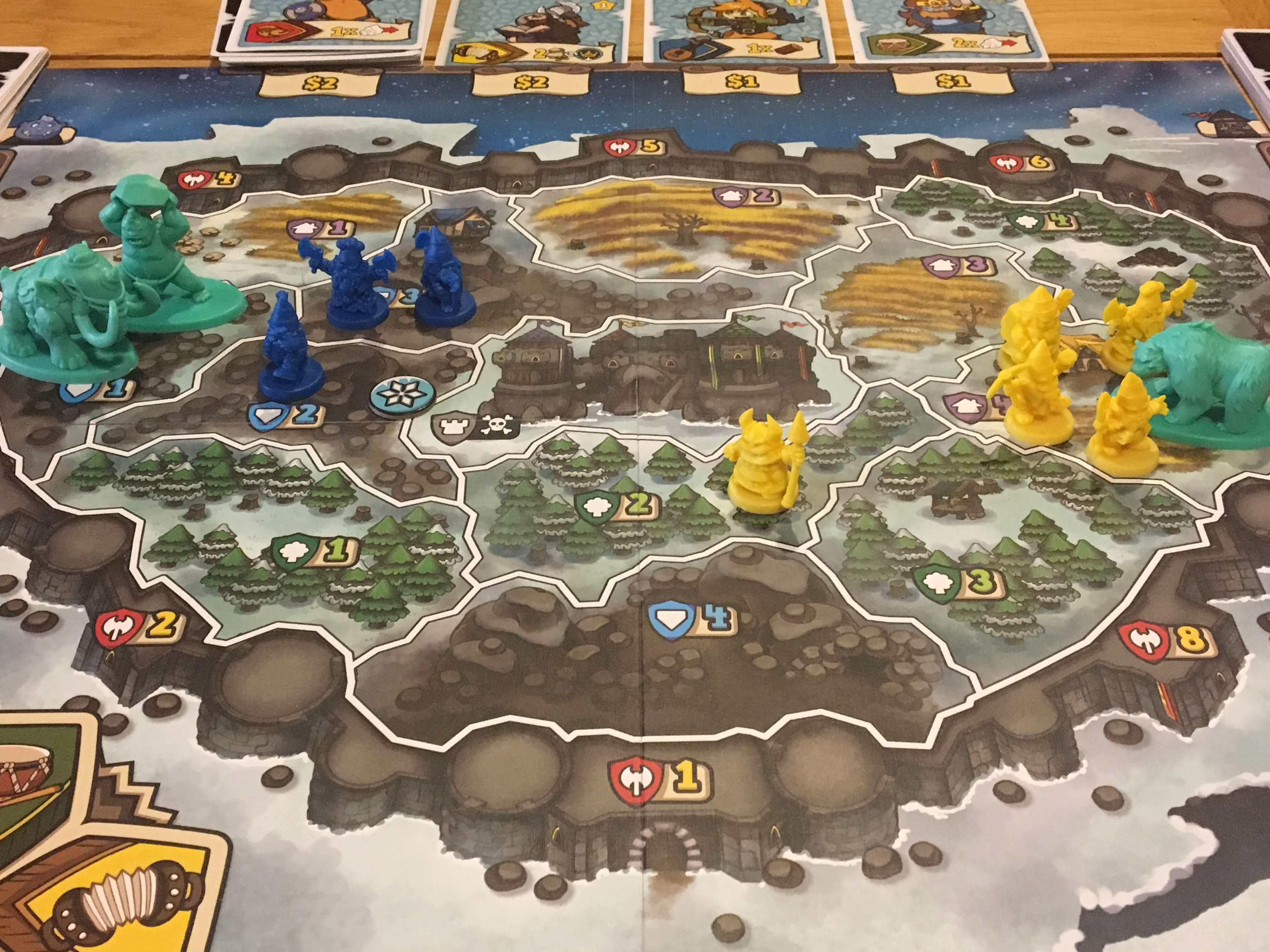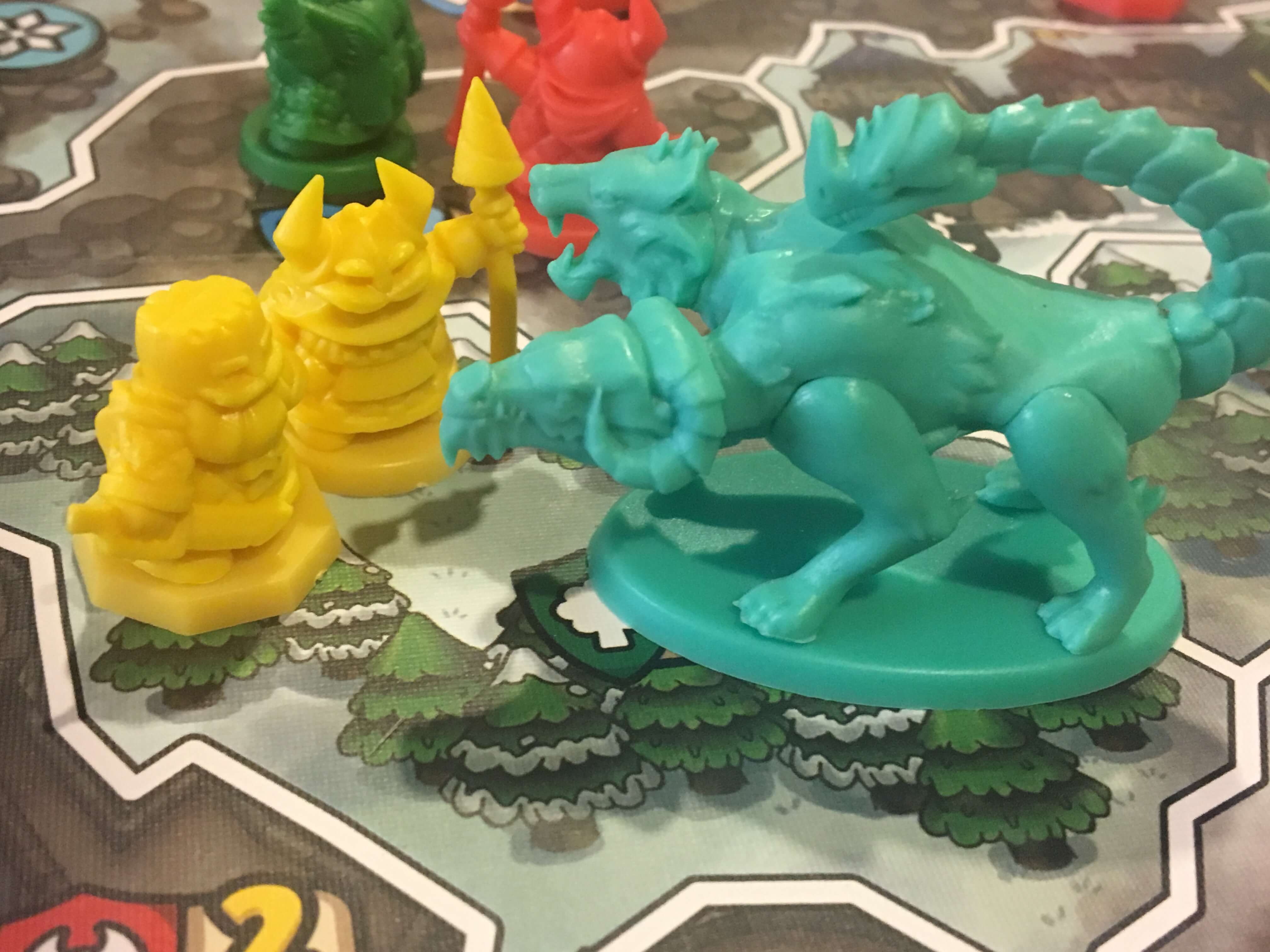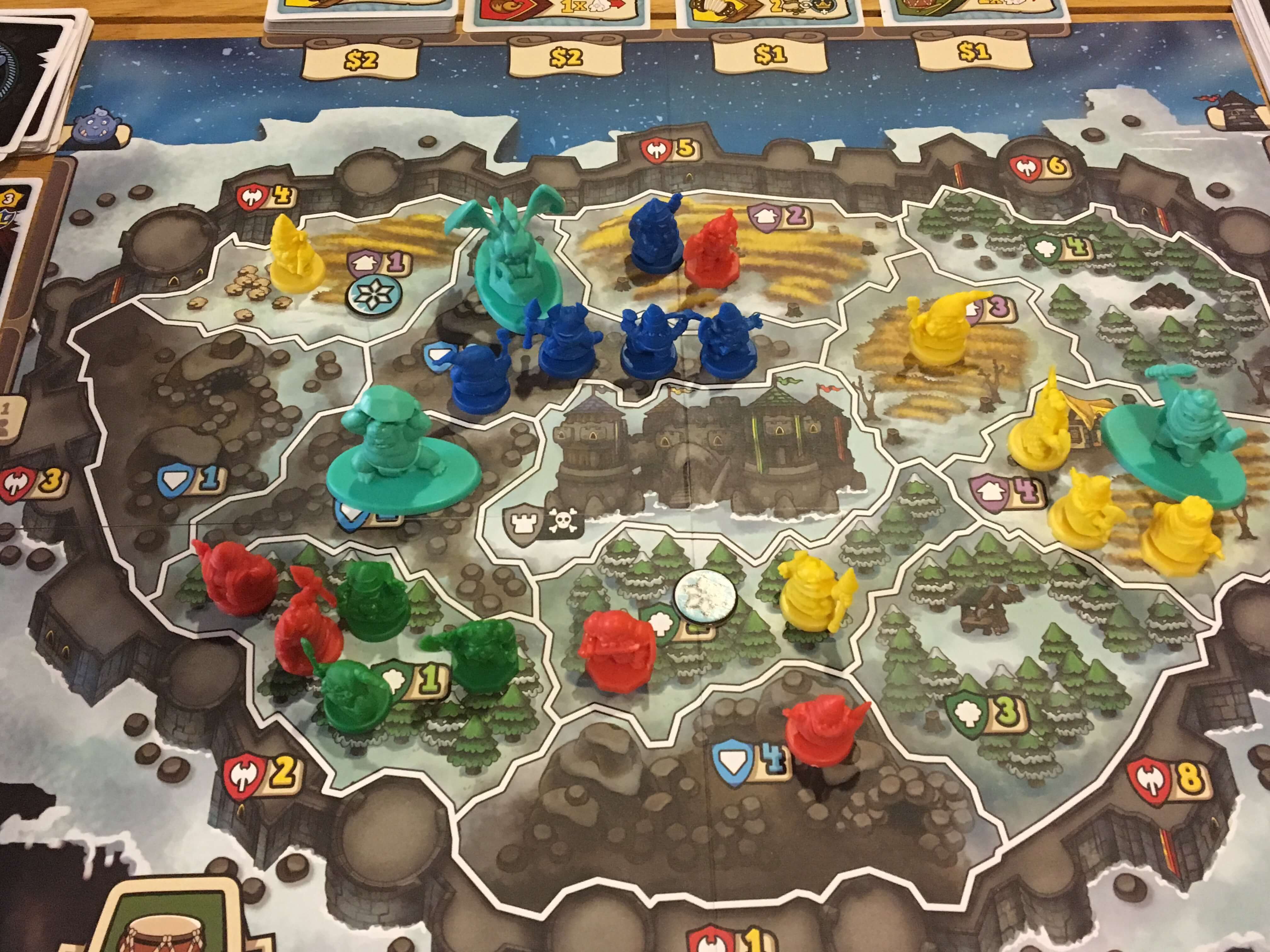Dwar7s Winter review — oh baby, it’s cold outside
![]()
- Aside from having a name that is incredibly annoying to write thanks the inclusion of an errant number, Dwar7s Winter is a compact, straightforward and attractive tower defense board game set in a cartoonish fantasy world. Winter follows on from Vesuvius Media’s previous Dwar7s game (fall) and takes around thirty minutes to an hour to play, depending on experience level, number of players and so on. Perhaps most notably, Winter is both designed and illustrated by one man; Luis Brueh, which is a remarkable feat given how charming it looks.
Overview
There isn’t much fluff surrounding the world that our heroic dwarves live in, but that’s okay because the theme of Winter is quite interchangeable. Younger players could make up their own stories about it based on what happens on the board and anyone who has played a tower defense video game will be able to apply the thematic elements to their favourite digital game. None of this is a problem, in my opinion, because it keeps Winter focused almost entirely on gameplay and that’s never a bad thing.
The set up in Winter varies slightly depending on player count, but the players will always have three key objectives in mind. The first two are similar and involve handling the threat posed by various monsters who will make their way across the map, towards the dwarves central stronghold. If a turn ends with a monster in that space, then all players lose. The second thing to worry about is disasters, with a new one drawn after each round of turns. Simply put, if there are ever four of these in play when a fifth would be drawn, then once again, everyone loses.
The final objective is less about the greater good and more about winning the game on an individual level. Winter is a victory point game, really, even though there are shared loss conditions. After seven weeks (game rounds) of winter, the player who has the most victory points across the heroes they have drafted, the enemies and disasters they’ve defeated and as the result of one or two other areas of play, will win. Turns in Winter last for a minute or two each and there are some elements of simultaneous play, so it’s rare for anyone to get bored whilst playing.

Components
The only edition of Winter currently available includes both the Legendary Expansion (which adds eight additional monsters, twelve more dwarf miniatures and a few new cards to the base game) and a full set of miniatures. I had originally thought that there must be a more basic version of the game, since this one is remarkably generous, but I am assured that this is the single, retail product, which makes it an impressive package.
Winter is a fantastically well made game, with beautiful plastic models for the dwarves (seven of each colour, plus three from the Legendary Expansion) and the monsters. Whilst not the most detailed models I’ve ever seen, Winter’s miniatures capture the character of the card art well, giving a clear thematic link between models and printed components that make the game feel quite individual. There’s a bold, cartoonish style throughout that gives everything a large amount of character.
The card art of Winter is well done too, with large decks for dwarf heroes, disasters and monsters all nicely drawn and full of life. Each card features a clear layout showing any cost to pay, a value in victory points, what the card does and so on, whilst also leaving room for a fun little image of what the card actually demonstrates. The disaster and monster cards clearly show what’s happening — moose eating the crops, a frost giant marauding etc — but the hero cards use slightly vague images that don’t do much from a storytelling perspective. As I said earlier, this isn’t really a problem as players can make up their own fluff to surround the gameplay.
Other components include some really tidy player boards that track resources using a number of tracks. These boards are extremely clear and aside from the fact that the various crate and scroll tokens that sit on them are extremely small (making them very fiddly) I really welcome this approach, rather than the usual “pile of wooden resources” that most games favour. The instruction manual is small, cute and well laid out, but I do feel that there are perhaps three or four rules that need to be clarified. The movement of monsters is open to interpretation, as is whether or not placing more than one dwarf in a space will generate additional resources.
Overall, if you do pick up Winter, I think you’ll be very impressed by the component quality. The dwarf and monster miniatures come in a wide variety of poses, shapes and sizes (especially with the Legendary Expansion extras) and there’s enough in the box to ensure that you won’t see a lot of repetition in monsters and disasters from one play to the next.

Turn structure
Turns in Winter are fairly simple, although there is a fairly unique action that allows players to act out of turn as a kind of follow action. At the beginning of each week (or round) the players must first move monsters and activate their abilities. This, in short, means that each active monster will move one space closer to the central castle, which in most cases will take them four turns to reach. Once moved, the monsters will activate their abilities, which usually affect all players with a dwarf either in or adjacent to the monsters space. Monster abilities can cause a player to reduce their hand size, lose a dwarf or be forced to sacrifice a resource, for example.
Next, the players check for monster reinforcements. The game requires a set number of monsters to be in play on each turn, depending on the player count. In most cases (except four player) this is the same as the number of players, plus one. At four players, the game requires four monsters. When a monster is spawned, a card is drawn from the top of a deck and the monster shown is placed in the location indicated by the card — it’s really very simple. Next, a disaster will always be spawned in much the same way, with the difference being that if disasters are not dealt with, the players will immediately lose when a fifth would be drawn and the previous four have not been resolved.
Next, the players prepare for the upcoming round. Each player has a basic deck of seven (eight with the Legendary Expansion) cards that allow them to do various things that I’ll explain in a moment. These cards can be added to by purchasing heroes from a shared store, which again, I’ll explain in a moment. For now, the players must choose cards up to their hand limit (which is seven, unless monster abilities have reduced it) which will be available to them during the upcoming round. Beginning with the first player and moving clockwise, they will then begin to take actions.
Each player has a default of six actions to take (which again can be reduced by monsters) and they include placing a dwarf or moving one that’s already on the board for one action each, both of which are self-explanatory. The next action, purchasing a hero card, is also fairly simple — the player simply pays a number of gold as indicated below the card, then takes it and adds it to her pile of cards that are not in their hand this round. In effect, it’s not possible to buy a card and use it in the same round of actions.
The final, major action is called Play Music and represents perhaps the most interesting and unique mechanic in Winter. When a player chooses this action, she must first choose an instrument/colour that has not been played so far — red, for example — and then places her music token onto the red instrument space on the board. One by one, she may then play all cards in her hand that relate to the red instrument. For red specifically, the cards often relate to things like producing money, upgrading standard dwarves to elite ones or similar. For the other colours, the cards often allow the player to generate resources of different types (wood, stone or food.) Once the first player has completed all the red cards that she wishes to, each other player can take a follow action and play their own red cards — even though it is not their turn.
At any point in their turn, the player may take the free action to either defeat a monster or resolve a disaster. To do so, they must simply have the number of dwarves indicated on the monster or disaster card in the right area, and they must then spend the number and type of resources that the card shows. A monster, for example, might demand that four dwarves, one stone and one wood be consumed. At this point, the player adjusts their resource tracks accordingly and returns the dwarves to their player board, then takes the associated monster or disaster card (which will be worth points later).
Once each player has taken their actions, the first player token moves around the table, the winter track advances one week and the next round begins, assuming that no monster is present in the central keep (causing a loss).

Game experience
Whilst tower defense games are becoming more and more popular in board gaming, few seem to capture the feel of the video games which inspire them. Dwar7s Winter is a notable exception to the rule, I’d say. There’s an immediacy to it that enables players to cascade events within the same turn to great advantage for instant gratification, but there’s also a need for teamwork and a bit of forward thinking if you intend to make it to the end. From turn four, the game can descend into a free-for-all since it’s possible to be in a position where no monsters can reach the keep and that’s something that sets a very different tone from one game to the next.
The components, as I mentioned earlier, are exceptional and I really do think that they add a physical presence to the game that feels thematic, interesting and fun. I’m not sure that Winter would feel quite so impressive without them and nor would it be as interesting or as variable without the Legendary Expansion content, so I’m glad these things come bundled in the retail box. Difficulty wise, I felt that Winter was a little too easy in certain configurations, but that may be why the manual includes rules for a harder variant — I haven’t had chance to try it yet, but having read the changes it involves, I can see how it would have increased the challenge levels.
I have played Winter at one, two and four players and whilst it’s fun at any count, solo is the most challenging. Four player mode seemed a little too easy to me, unfortunately, but that could vary based on player experience. If you were playing with less than four players and found the game too difficult, it would be entirely possible to simply control more than one dwarf team per player, for example. On a related note, I find it fairly rare that semi-cooperative games work well, but Winter does so superbly, thanks to the fact that it uses joint loss conditions mated with individual win conditions — this means that everyone is incentivised to do their best for the group, but it also clearly rewards the greatest individual contribution.

Conclusion
Overall, a combination of exceptional components and a fast, simple structure mean that Dwar7s Winter is a successful tabletop replication of a tower defense game. If you think that such a concept is of interest to you, then this is the game that I think represents the digital equivalents in physical form most accurately and with the best balance of fun and gameplay weight. Winter is an easy game to learn and to teach, but you do need to optimise your turns fairly well in order to be successful. The Play Music action is a really interesting and unusual addition to this kind of game and it does make players think carefully about which cards to take into each round of actions.
With Christmas coming and a number of long, cold months ahead, Dwar7s Winter feels like a very appropriate game to be playing. It’s a family title and those semi-cooperative objectives should mean that families with children of around ten to fifteen years of age will particularly enjoy this one. It’s going on my long term keep shelf, so I have no choice but to recommend Dwar7s Winter as an excellent example of the genre it represents.
A copy of Dwar7s Winter was provided for review purposes. You can find out more about it on the website of publisher Vesuvius Media.

Comments are closed.